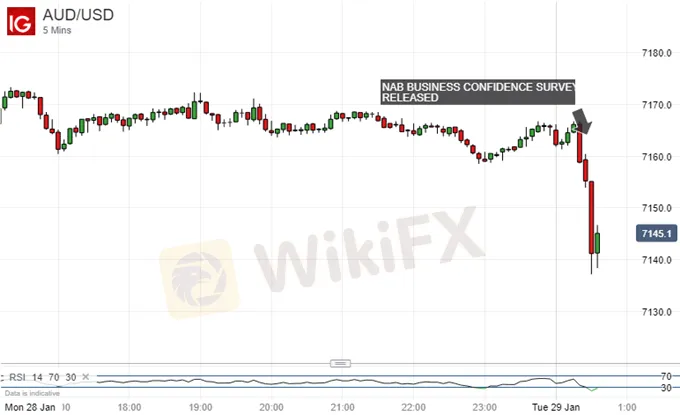简体中文
繁體中文
English
Pусский
日本語
ภาษาไทย
Tiếng Việt
Bahasa Indonesia
Español
हिन्दी
Filippiiniläinen
Français
Deutsch
Português
Türkçe
한국어
العربية
Australian Dollar Slips On NAB Business Gloom, Trade Talks Eyed
Abstract:The Australian Dollar took a Tuesday fall on news that domestic businesses assessment of current conditions had worsened very markedly
Australian Dollar, NAB Business Confidence Survey, Talking Points:
AUD/USD was marked down after another feeble business survey
Overall confidence was steady, but at very low level
The ‘current conditions’ assessment was brutal
First-quarter technical and fundamental forecasts from the DailyFX analysts are out now.
The Australian Dollar wilted Tuesday on a very gloomy assessment of current conditions from Australian businesses.
Overall business confidence remained stable in December according to the National Australia Bank‘s venerable survey, albeit at very low levels. The index reading of 3 matched November’s print but that was the lowest since January 2016. What really did the damage to AUD/USD, however was that current conditions assessment.
Its reading plunged to just 2, from 11 in November.
Business confidence had been holding up pretty well until the end of last year, but is now running at just half of the surveys long term average of 6.
Australian business remains very vulnerable to the clear slowdown visible in much Chinese data, given China‘s importance to Australia’s raw material export machine. Indeed Australian businesses will be hoping as hard as any that this weeks high level bilateral trade talks between Beijing and Washington will bear some tangible fruit.
Market watchers seem to think that a durable deal remains some way off, even assuming that it is possible. Given that, success is likely to be measured in willingness to pursue further talks and, perhaps, an end to the tit-for-tat tariff raising which made markets so volatile last year.
AUD/USD was clearly hit by the NAB survey and dropped about 30 ticks in short order after its release.

On its broader, daily chart AUD/USD remains above the downtrend channel which dominated trade for much of 2018, as US interest rates rose and Australias remained doggedly at their record low of 1.50%
The Aussie has bounced into 2019 as investors rethink the likely magnitude of US rate rises ahead and as hopes for a trade breakthrough buoy growth-linked assets like the Aussie.

It could continue to gain this week if the US Federal Reserve strikes a more dovish tone when it sets monetary policy on Wednesday.
However, Australian rate futures markets now strongly suggest that the next move in Australian interest rates may yet be a fall, even though the Reserve Bank of Australia still insists that a rise is more likely. A near-term steer on who is likely to be right here (and they can‘t both be), may come from Wednesday’s Australian inflation data. More weakness is expected with an annualized rise of just 1.7% predicted. If that is seen then the markets are likely to remain convinced that lower rates remain a distinct possibility.
For as long as the Australian Dollar completely lacks interest rate support, it is likely to remain vulnerable. It‘s notable that recent AUD/USD strength has not taken the pair past its recent significant high (early December’s 0.7393).
Disclaimer:
The views in this article only represent the author's personal views, and do not constitute investment advice on this platform. This platform does not guarantee the accuracy, completeness and timeliness of the information in the article, and will not be liable for any loss caused by the use of or reliance on the information in the article.
Read more

KVB Market Analysis | 28 August: Yen Strengthens on BoJ Rate Hike Hints; USD/JPY Faces Uncertainty
The Japanese Yen rose 0.7% against the US Dollar after BoJ Governor Kazuo Ueda hinted at potential rate hikes. This coincided with a recovery in Asian markets, aided by stronger Chinese stocks. With the July FOMC minutes already pointing to a September rate cut, the US Dollar might edge higher into the weekend.

KVB Market Analysis | 27 August: AUD/USD Holds Below Seven-Month High Amid Divergent Central Bank Policies
The Australian Dollar (AUD) traded sideways against the US Dollar (USD) on Tuesday, staying just below the seven-month high of 0.6798 reached on Monday. The downside for the AUD/USD pair is expected to be limited due to differing policy outlooks between the Reserve Bank of Australia (RBA) and the US Federal Reserve. The RBA Minutes indicated that a rate cut is unlikely soon, and Governor Michele Bullock affirmed the central bank's readiness to raise rates again if necessary to combat inflation.

KVB Market Analysis | 23 August: JPY Gains Ground Against USD as BoJ Signals Possible Rate Hike
JPY strengthened against the USD, pushing USD/JPY near 145.00, driven by strong inflation data and BoJ rate hike expectations. Japan's strong Q2 GDP growth added support. However, USD gains may be limited by expectations of a Fed rate cut in September.

KVB Market Analysis | 22 August: Gold Stays Strong Above $2,500 as Fed Rate Cut Hints Loom
Gold prices remain above $2,500, near record highs, as investors await the Federal Open Market Committee minutes for confirmation of a potential Fed rate cut in September. The Fed's dovish shift, prioritizing employment over inflation, has weakened the US Dollar, boosting gold. A recent revision showing the US created 818,000 fewer jobs than initially reported also strengthens the case for a rate cut.
WikiFX Broker
Latest News
ASIC Sues Binance Australia Derivatives for Misclassifying Retail Clients
Geopolitical Events: What They Are & Their Impact?
Top 10 Trading Indicators Every Forex Trader Should Know
WikiFX Review: Is FxPro Reliable?
Malaysian-Thai Fraud Syndicate Dismantled, Millions in Losses Reported
Trading frauds topped the list of scams in India- Report Reveals
Why Do You Feel Scared During Trade Execution?
WikiFX Review: Something You Need to Know About Markets4you
Revolut Leads UK Neobanks in the Digital Banking Revolution
Fusion Markets: Safe Choice or Scam to Avoid?
Currency Calculator


